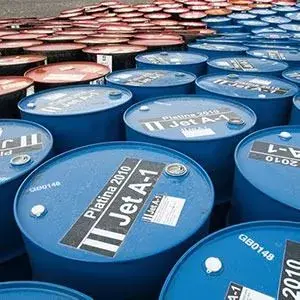
EN 590

EN590 10PPM
We offer EN590 10PPM fuel, sourced globally. We can facilitate significant cost savings on EN590 10PPM fuel through direct procurement from verified suppliers.

ORIGIN
Non-Russian/Non-Sanctioned OPEC Member countries, or EU

PRODUCT DESCRIPTION
Jet A-1 is a high-quality, kerosene-type jet fuel used in most commercial and military turbine engines worldwide, with key specifications including a flash point above 38°C and a freezing point of -47°C. It is characterized by its suitability for lower-temperature environments, its compatibility with most jet aircraft, and its compliance with stringent international standards like DEF STAN 91-91 and ASTM D1655

KEY CHARACTERISTICS
-
European Standard:
-
Developed by the European Committee for Standardization (CEN), it is the benchmark for diesel fuel quality in the European Union and several other countries.
-
Environmental Focus:
-
The standard was introduced to reduce sulfur content in diesel fuel, which helps to lower sulfur dioxide emissions and mitigate their environmental impact.
-
Ultra-Low Sulfur Diesel (ULSD):
-
Diesel fuel conforming to EN 590 is considered Ultra-Low Sulfur Diesel (ULSD) in the EU, with a sulfur content typically around 10 parts per million (ppm).
-

Specifications and Standards
EN 590 defines requirements for various fuel properties, including:
-
Sulfur Content: A key parameter for reducing air pollution.
-
Cetane Index: A measure of the fuel's ignition quality.
-
Density: The mass per unit volume of the fuel.
-
Distillation Characteristics: How the fuel vaporizes at different temperatures.
-
Cold Filter Plugging Point (CFPP): The temperature at which fuel will begin to solidify and clog filters, crucial for cold weather performance.
-
Oxidation Stability: The fuel's resistance to degradation over time.
-
Biodiesel Content:
-
The standard permits the blending of up to 5% (or 7% in some cases) of fatty acid methyl esters (FAME) from renewable sources into the diesel fuel.
-
Climatic Grades:
-
EN 590 categorizes diesel fuel into different grades (A-F for temperate climates and 0-4 for arctic climates) based on their cold filter plugging point to ensure proper performance in various weather conditions.
-
-
Vehicles: EN 590 diesel is used in passenger cars, trucks, and buses that run on diesel engines.
-
Machinery: It powers construction, agricultural, and other heavy equipment with diesel engines.
-
Power generation: This fuel is suitable for generators and auxiliary power units.
-
Low-sulfur content: Modern EN 590 diesel has an ultra-low sulfur content, typically 10 parts per million (ppm), to reduce harmful emissions of sulfur oxides into the atmosphere. This makes the fuel compatible with modern vehicle exhaust systems, such as Diesel Particulate Filters (DPFs) and Selective Catalytic Reduction (SCR) systems.
-
Climate grades: The standard defines different grades of diesel suitable for specific climates, with summer and winter grades offering varying cold-flow properties to prevent the fuel from gelling in low temperatures.
-
Biodiesel blends: EN590 allows for the blending of up to 7% Fatty Acid Methyl Ester (FAME) biodiesel with conventional diesel fuel.
-
EN 590 vs. older/non-compliant diesel
The most significant difference lies in the sulfur content. Modern EN 590 diesel has a maximum sulfur content of just 10 parts per million (ppm), a dramatic reduction from older diesels that contained hundreds or thousands of ppm.
EN 590 vs. gasoline
While both are petroleum-derived fuels for internal combustion engines, they are chemically distinct and cannot be interchanged.
EN 590 vs. other diesel standards and alternatives
-
vs. ASTM D975 (U.S. diesel): EN 590 has a higher minimum cetane number (51 vs. 40) and slightly different specifications.
-
vs. Renewable diesel (HVO): Renewable diesel, made from fats and oils, is even cleaner than EN 590 and produces lower emissions of particulates, NOx, and CO. It meets the EN 15940 standard for paraffinic diesel fuels.
-
vs. Other alternatives: Fuels like Natural Gas Liquids (NGLs), electric power, and biofuels have different applications. EN 590 is used for heavy-duty vehicles, while NGLs might be used in smaller cars. Electric vehicles offer zero tailpipe emissions but require charging infrastructure.
-
